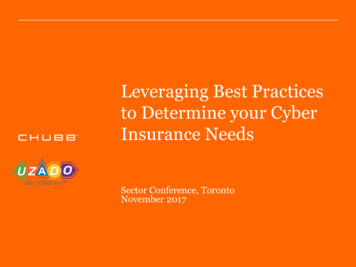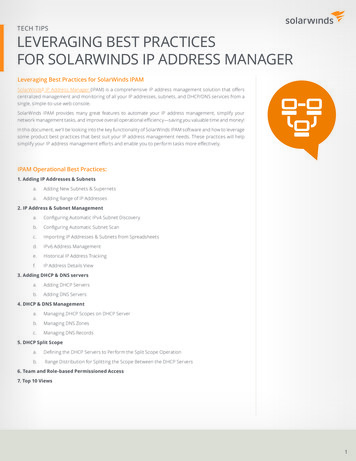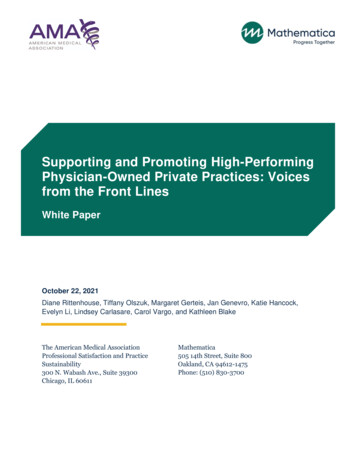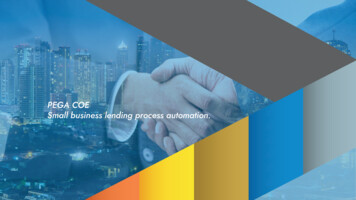
Transcription
Leveraging Best Practicesto Determine your CyberInsurance NeedsSector Conference, TorontoNovember 2017
Chubb DisclaimerThe views, information and content expressed herein are those of the author and do not necessarilyrepresent the views of any of the insurers of The Chubb Group of Insurance Companies. Chubb did notparticipate in and takes no position on the nature, quality or accuracy of such content. The informationprovided should not be relied on as legal advice or a definitive statement of the law in any jurisdiction.For such advice, an applicant, insured, listener or reader should consult their own legal counsel.2
Presenters:Matthew Davies, Vice PresidentDave Millier, CEOCanadian Product Manager –Professional, Media & Cyber LiabilityUZADOChubb Financial Lines3
Agenda Cyber Insurance 101 Cyber Exposures – beyond just IT issue What does a Cyber Policy cover? Cyber Claims – What Have We Been Seeing? Cyber Underwriting Process Cyber COPE From Concept to Reality Sample Cyber COPE Score Card Summary4
Cyber Insurance 101
What the Privacy Commissioner of Canada Wants toKnowBe prepared to respond to at leastthe following four questionsduring a privacy regulatoryinvestigation of a security incidentin your organization:Show us your organization’sinformation security governanceprogram.Show us evidence of regular trainingand awareness.Show us evidence of your compliancemonitoring.Show us your organization’s securityincident protocol, and walk us throughhow you implemented tions/illustrations/6
No matter how good your Security Controls are ns/illustrations/7
Cyber insurance in a nutshellIncidentResponseCoach ServicesLegal ServicesFirst-PartyExtortionThird-PartyPrivacy Liability Regulatory Defence PCI AssessmentForensicsBusinessInterruptionNetwork LiabilityNotificationRestorationMedia LiabilityCyber CrimeTechnology E&OCredit MonitoringPublic Relations8
Chubb Exposure Stats by Trigger Over the Last DecadeLost/Stolen Devices 2014 – 14% 2015 – 11% 2016 – 10% 2017 – 6%Hack 2014 – 27% 2015 – 40% 2016 – 33% 2017 – 20%Rogue Employee 2014 – 15% 2015 – 13% 2016 – 5% 2017 – 15%Source: Chubb’s claims data as of October 2017 – based on approximately 3,000 Claims9
Chubb Cyber Bad Actors Over the Last DecadeInternal Employees, independentcontractors, internsExternal Criminal groups, hackers, formeremployees, government entitiesPartner Suppliers, vendors, outsourced IT,hosting providersSource: Chubb’s claims data as of October 2017 – based on approximately 3,000 Claims10
Chubb Cyber Affected Assets Over the Last DecadeServer Database, email, virtual, physical, webNetwork Local, wireless, routers, firewallsUser Device Desktop, laptop, smartphone, POSterminalPublic Terminal ATM machines, pay at pump gas stationsMedia Paper documents, USB drives, CDsPeople Developer, admin, executive, end userSource: Chubb’s claims data as of October 2017 – based on approximately 3,000 Claims11
Cyber Targets by Organization’s Employee CountSource: Symantec Internet Security Threat Report 2017 Volume 2212
The “Perfect” RiskWhat Underwriters are looking for:– Board level and executivemanagement engagement– Enterprise wide risk managementattitude– Up-to-date data security andprivacy policies– Annual employee awarenesstraining– Incident management plans (BCP,DRP, IRP)– Data protections – encryption,segregation, back-ups, devicetracking– Vendor due diligence– Continuous /publications/illustrations/13
Cyber COPE 14
Pop QuizPart 1 – Property Assessment1. How many floors are in your office building?2. Can you name three materials that your office building is made of?3. Does your building have a central fire detection alarm system?Part 2 – Cyber Assessment1. Does your company encrypt all sensitive data at-rest and in-transit?2. Do you provide your staff with training on systems security?3. Does your company use any unsupported software?15
QuestionSo if the number of floors in a building or the age of asprinkler system can be used to help assess your commercialproperty risk, why can’t something like the number ofcomputers or the currency of software in service in acompany be used to more accurately assess cyber risk?16
COPE Property Underwriting OPE17
What makes COPE effective for property? It’s simple to understand Provides objective data points Provides subjective data points Balance of objectivity and subjectivity Use of publicly available information Promotes discussions on loss control18
Cyber COPE Launched in 2016, a new model for cyber underwriting, intended to simplify andimprove the assessment of both cyber and privacy risks with four primary goals:1. Accessible to both technical and non-technical audiences2. Provide both objective and subjective measurements3. Foster information sharing so that organizations can learn from each other tohelp mitigate future losses4. Open opportunities for innovation by the insurance and security industry19
Cyber COPE Proposed Cyber Risk ntsExposuresCyberCOPE 20
Transforming COPE to Cyber COPE COPEConstructionCyber COPE ComponentsMeasurementSample Data ElementsObjectiveNumber of endpoints and networkconnections, software versions, anddata center r’s industry, quality of ITand security related policies, and useof industry standards, revenue, ITsecurity budget, compliance (PCI DSS,other standards)ProtectionProtectionSubjectiveData retention policies, firewalls,monitoring, and incidentresponse/response readiness policiesSubjectivePolitical or criminal motivation, typesof outsourcing, and type/amount ofsensitive informationExposuresExposures21
Cyber COPE Usage Current Full cyber white paper published on Chubb.com Assessment to support Chubb’s Global Cyber Facility FireEye’s Cyber Insurance Risk Assessment (CIRA) In Progress Adapt underwriting questionnaire for use with Small Commercial and MiddleSized Enterprise Customers Alignment with other industry standards ISO27001, NIST, PCI-DSS, OCE Integration with internal data analytics and external partners22
23
A Brief History – Uzado and Cyber COPE Russ Cohen publishes a white paper Cyber COPE – Transforming Cyber Underwriting Uzado and Russ chat and discuss cyber risk and how insurance can play a pivotal role Uzado proposes to build the initial draft framework leveraging industry best practices, the NISTCybersecurity Framework (CSF) and the Center for Internet Security Critical Security Controls (CSC) Uzado builds the draft framework into a working model including risk measures, maps the frameworkagainst other industry frameworks and standards Uzado and Chubb look for opportunities to leverage the framework in existing insurance practices24
Cyber Security Lifecycle25
Aligning the Lifecycle to Maturity Levels Lifecycle broken into 4 phases, each feeds the next phase Companies need to determine where they are at in the lifecycle as it relates to their cyber risk maturitylevel Each level of the lifecycle corresponds to a maturity level Planning Maturity Level 1 Company is just starting out on their cybersecurity journey Implementation Maturity Level 2 Company has identified what they need to do to improve theirrisk posture and has started to take steps forward Manage Maturity Level 3 Company has implemented various security safeguards and is activelymanaging them with a goal of identifying security threats and responding in real-time Validate Maturity Level 4 Company is periodically testing their security controls for effectiveness,performing continuous improvement activities, restarting the lifecycle as appropriate26
Aligning The Lifecycle to Cyber COPE Plan: Determine what Components make up the network Identify the maturity level of the Organization Decide what Protections are required Capture an accurate list of any Exposures the Organization may faceImplement: Build out any policies and processes that are required Deploy tools and technologies to better secure the environment Ensure that any identified exposures have at least one corresponding protectionManage: Ensure policies and processes are mapped to workflow activities that will help you not just Attain some level of risk management but also maintain it on an ongoing basisValidate: Build and follow a set of activities that help to measure the effectiveness of each control Rinse and repeat as often as deemed necessary27
Standards and Frameworks and Best Practices, Oh My! Logical next step was to map the Cyber COPE controls to various other controls To date, we have mapped: NIST CSF CIS CSC OSFI CSA NERC CIP PCIGoal is to allow organizations to gain insights into where they are currently at as it relates to variousother standards, frameworks, or best practice activities28
Using Cyber COPE to Determine Risk Score is mapped to other frameworks and uses a maturity model that looks something like: 1 Ad Hoc or not doing it 2 Partially Implemented 3 Mostly Implemented 4 Implemented, Continuous Improvement N/A Not Applicable Based on the answers to the Cyber COPE questions, along with the self ranking of maturity,determine an initial Risk Score Compare the Score against other companies in the same industry Provide guidance and recommendations on remediation activities based on areas that are rankedlower and require further attention Assume anything lower than 3 should be addressed29
Cyber COPE to Determine Appropriate Insurance Products Some of the Cyber COPE questions focus on certain areas that insurance would be appropriate toprotect For example, a company that has a lot of credit card data may want to purchase additional insurancethat would provide identify theft monitoring to clients affected by a breach A company that relies on a third party’s IP (Intellectual Property) may purchase insurance thatprotects it in the event the IP entrusted to that organization by its business partners is stolen,tampered with, or deleted A company that relies heavily on the Internet to deliver services may buy business interruptioninsurance to protect them in the event they are subjected to a DoS (Denial of Service) which impactsthem to the point where they cannot deliver services to their clients30
11/23/2017Gaining Traction for Cyber COPE – It Takes Time The Cyber COPE framework will take time to be adopted Needs industry recognition, review and validation Insurance companies will need to get used to seeing the Cyber COPE results as part of cybersecurityinsurance application documents Start out with a small set of questions, get companies comfortable, then present the morecomprehensive questionnaire Use it as part of an overall insurance quotation and coverage, not just for cyber insurance31
Measure A Little, Then a Lot Ask a few questions to introduce the concept of Cybersecurity risk Based on answers, present findings in a non-technical, easy to understand answer complete withexplanations and recommendations Based on the situation, it may be the company who’s responding who answers the question or anInsurance Broker may answer the questions on behalf of that Broker’s client Assuming company wishes to get more information on insurance offerings available to them, theywould then proceed to completing the more comprehensive application Key is to keep them informed of their progress throughout the application cycle, provide insights intothe meaning of all of the unfamiliar terms and acronyms, make it as simple as possible Provide results in an easy-to-understand format, measurable, company can see dashboards whichbreak results down in easy-to-digest way, can create and save reports and scorecard32
Cyber COPE CYBERSECURITYASSESSMENTSAMPLESCORECARD33
Overall Cyber COPE Risk Score42%40%02GOALSAverage Industry ScoreEnsure your Organization is ready toidentify and respond to a cyber-attack60%0150%0340%040559%Current Score20%Ensure your Organization has visibility into real-time activity ontheir network & systemsYour Organization regularly tests the defencesYour Organization has clearly defined roles & responsibilitiesYour Organization has proper documentation34
Results by Cyber COPE tion0-30%Protections31-69%Exposures70-100%35
Your Current Maturity Aligned To 1Requirements36
How Ready Are You To Implement Other SecurityFrameworks?59%PCINERC CIPNIST CSFCIS CSCOSFI CSA21%22%34%68%37
Changing Insurance from Static/Reactive to Proactive Current approach to security: answer some questions once, get a quote, buy insurance Proposed approach with Cyber COPE : Make it useful and beneficial to answer and update thequestions and responses more often, possibly quarterly or semi-annually Provide incentives for companies to do so (either lower limits, higher rates or deductibles if they don’t,or higher limits, lower rates or deductibles if they do and can demonstrate they have taken measurablesteps to improve their overall risk posture) Make the insurance process more proactive, providing guidance so that companies can reduce theirrisk to minimize breaches; benefits the insurance companies (fewer claims), benefits the clients (fewerbreaches) Use Insurance products as a reason for companies to become more aware of their exposures andideally better manage their risk. Insurance costs are often of interest to the Board of Directors, sofinding ways to improve them can result in greater Board engagement in the entire process.38
Key Things to Remember The Cyber world is changing: use these changes as an opportunity to improve your overall risk posturewhile at the same time gaining a better understanding of how to protect your organization. A lot of small changes really can improve your overall risk score; you have to start somewhere, have aplan and have a way of measuring progress. Approach cybersecurity thinking of it as a lifecycle; it never ends, you will be at different places in thelifecycle at different times and for different activities. Security is not absolute, but the planning you do now and the efforts you take can and WILL make adifference! Cyber insurance is part of an overall enterprise risk management strategy – target harden and preplan the elements of your response, transfer the financial risk; and then when an event happensactivate your plan and engage with your Cyber insurer.39
Chubb. Insured.
security budget, compliance (PCI DSS, other standards) Protection Protection Subjective Data retention policies, firewalls, monitoring, and incident response/response readiness policies Exposures Exposures Subjective Political or criminal motivation, types of outsourcing, and type/amount of sensitive information 21











